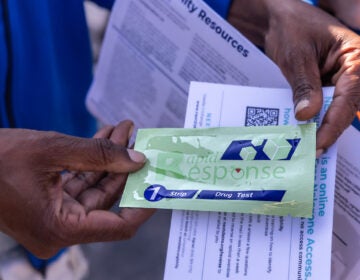Trying to manage mental illness in the workplace
ListenWhen the CEO responds to your out of the office email about taking sick leave for mental health and reaffirms your decision. :100: pic.twitter.com/6BvJVCJJFq
— :skull:metal-and-bones:skull: (@madalynrose) June 30, 2017
Tales from the cube and the restaurant floor.
For as long as she can remember, Madalyn Parker has always been anxious, even as a kid. But by college, she wasn’t sure she’d survive.
“I have multiple school notebooks that have half-finished suicide notes in them. I’m a little bit shocked that I made it through,” Parker said.
Along the way, she was diagnosed with severe depression. Still, Parker did graduate, with a computer science degree from Michigan State in 2013. Right after that, she landed a job at a software company, Olark, which has an office in Ann Arbor.
“It gave me new life,” Parker, who’s now 26, said. “I was so happy to have this job. I was so happy to feel valued right away.”
Things were great. But then, they weren’t.
Her depression medications stopped working. She started calling in sick.
“I mean, this isn’t something that you normally talk about at work, and the way that it presents makes me look like either I’m lazy or I don’t care or I’m bad at my job,” Parker said. “And so I was putting all of this pressure on myself, and it absolutely crushed me.”
Parker is one of many, an estimated 20 percent of the adult population, who’s experienced a mental illness. Of that, some 10 million are living with a serious mental illness, according to the National Alliance on Mental Illness. Yet, managing such conditions in the workplace can be really tricky, adding even more stress to an already stressful situation.
Bosses often don’t get it.
A majority of respondents, 52 percent, in a 2017 American Psychological Association survey of 1,512 adults reported that their employer does not offer adequate resources to meet their mental health needs.
What happened to Parker next, though, points to a culture that appears to be shifting, at least in some places.
A supervisor’s unexpected response
Initially, Parker kept the specifics of why she kept calling out sick a secret, but the internal stress mounted.
“On top of this, I was the only female engineer at my job,” Parker said. “I didn’t want them to extrapolate that women are lazy, women are bad at their jobs.”
After a lot of back and forth, she went for it and decided to tell her supervisor what was really going on.
The response floored her.
“He said, ‘I wonder who else feels like this. We should make sure that they know that it’s okay to take care of themselves and to take time off for this,'” she recalled. “I was absolutely blown away, because I was prepared for, ‘You might be fired.’ Because that’s what everyone told me I was going to hear, and that’s not what I heard at all.”
Word got up to the CEO, Ben Congleton.
“I mean, it just sort of pains me to think about people working at places where they feel like they have to hide an aspect of who they are,” Congelton said.
Congleton says in reality these conditions are common. So at work, he views it as no different from an employee who has a physical health condition, like the flu or diabetes.
“I think part of the reason mental health feels like something that’s different from the flu is because we haven’t really talked about it a lot,” he said.
Employers benefit
Congleton’s response doesn’t just make him an empathetic and good guy, according to Dr. Arthur Evans, head of the American Psychological Association. Evans says creating a work environment that supports people who have mental illnesses is actually good for business. These are common conditions in the workforce.
“Employers who have initiatives that recognize that their employees’ well-being is important tend to have much better employee outcomes like job satisfaction, employees’ ability to do their job well,” Evans said, referring to a 2016 APA survey. “It actually benefits not only the individual, but it benefits the employeer and the workplace.”
He also says supporting employees with mental illnesses isn’t necessarily a huge resource lift: It’s about changing the culture.
“What it really requires is the support of senior management,” Evans said. “And when you have that kind of support, it can make a big difference in how the organization is perceived by its employees in terms of their support.”
Employers who recognize workplace stressors and help reduce them, like by allowing more flexible time off or telecommuting, tend to have more productive employees, says Evans.
Congleton echoes this. Trusting employees to stay home or do whatever else they have to do to bring their full selves to work “increases overall performances, builds teams that have a lot of trust for each other, and overall, we just see it as part of creating a high-performing team.”
Workplace challenges
Still, for a lot of people, that’s just not a reality. It certainly wasn’t for Destinie Campanella.
“None of my supervisors or bosses or anybody was ever understanding of my mental illness,” Campanella said. “They just believed in, I guess, ‘tough love,’ if you want to call it. Pushing me.”
Campanella, who is 27 and lives in Philadelphia, has severe depression and PTSD from an abusive relationship. She works as an advocate now for people with mental illnesses, but before that, she had jobs at a restaurant and a daycare, the types of places that tend to have fewer worker benefits. She says she really struggled to get accommodations for things like therapy appointments.
“I felt so misunderstood,” Campanella recalled. “They made me feel worse. I thought, ‘Am I ever going to be able to hold down a job?'”
For many, paid sick days, in general, are a luxury.
Campanella says she barely made it through, but she also learned some important lessons. One of her biggest takeaways has been that self care is not selfish.
Through therapy, she discovered coping tools like boxing and writing poetry, which have helped channel her frustration and anxiety. She found creative ways to make time for herself at work.
“I wouldn’t get much of a break, but sometimes I would even lock myself in that bathroom and just say, ‘I need a moment.'”
Research from the APA, meanwhile, has found that Campanella’s experience may not be that uncommon.
“Only about a third of the employees out there are really paying attention to employee well-being,” Dr. Evans said.
Employee protections
Despite the challenges, there are legal protections that are supposed to be in place at work.
“People can request what’s called a reasonable accommodation,” said Alyssa Schatz, policy director at Mental Health Partnerships in Philadelphia, where Campanella also now works. “I think the challenge is that a lot of times people still don’t understand mental health. And so they don’t understand when they’re seeing something that should be a reasonable accommodation or something that should be responded to in a supportive, helpful way as opposed to a punitive, disciplinary way.”
Anecdotally, Schatz is seeing improvements in the workplace, but she worries the stigma sometimes associated with mental illness can still lead to discrimination on the job, which can have ripple effects elsewhere.
“That’s so tied to your financial well-being, your emotional well-being, your mental health overall,” she said.
Schatz acknowledges that the total scope of mental health discrimination at work is unclear, though the employment challenges that people with serious mental illnesses face, in general, is another story that she says is better documented.
Schatz says that’s also why it’s all the more important to be aware of workplace protections through the Americans with Disabilities Act. Employees have the right to request certain things.
“Some examples of a reasonable accommodation for someone with a mental health condition might be a more flexible schedule,” Schatz said. “So if you’re taking a medication that’s making you feel drowsy, you might be able to flex your schedule to come in at a later time. There are all sorts of different types of reasonable accommodations based on your situation, but you can request that through your employer.”
There’s also the Family Medical Leave Act. People can qualify if they’ve worked at a company of 50 or more employees for more than a year.
“That means that you can take a leave of absence from work for a medical condition or to take care of a loved one. And that includes having a mental health condition that you need to take care of for a while for up to 12 weeks, and during those 12 weeks you’ll still get your benefits,” Schatz said. “Your job will be protected, so you can’t be fired for taking that time if a health professional’s saying that you need it.”
Meanwhile, progress has been made on insurance coverage for mental health services, like through the essential benefits under the Affordable Care Act, and through the enactment of the Mental Health Parity Act. Still, Schatz says gaps exist.
“Most private insurance plans now offer a behavioral health benefit, but we still have a ways to go to make sure that it’s comprehensive enough to support people while they’re in the workplace transitioning to a private insurer.”
An exchange goes viral
As for Parker, she has been at her job for three years now. Her depression and anxiety haven’t magically gone away, though. She still has a lot of ups and downs that bleed into work.
She’s glad, though, she doesn’t have to hide it.
“God, just last week I was in the middle of a meeting, and I was getting close to having a panic attack,” Parker said.
After explaining that she was feeling anxious and needed a walk, she excused herself.
“No one batted an eye. And that’s huge,” she said.
In June, when things got really rough, she sent this email: “Hey team, I’m taking today and tomorrow to focus on my mental health. Hopefully I’ll be back next week, refreshed and back to 100 percent. Thanks, Madalyn.”
To her surprise, she got a response from Congleton, the CEO.
He wrote:
Hey Madalyn, I just wanted to personally thank you for sending e-mails like this. Every time you do I use it as a reminder of the importance of using sick days for mental health. I can’t believe this is not standard practice in all organizations. You’re an example to us all, and help cut through the stigma so that we can bring our whole selves to work.
“I thought that was pretty special,” Parker said.
It doesn’t stop there.
Parker had already started being more open about managing her illness at work. She gave presentations within the company and more publicly at tech conferences on the topic. It was within this context that, now armed with an email exchange that really moved her, she decided to take to social media.
She shared a screenshot of the email exchange in a tweet to some 400 followers. It appears to have struck a nerve.
As of late August, she had 557 replies, 16,453 retweets and 45,457 likes.
“I really was not expecting anything like this,” Congleton said.
Both say never underestimate the power of just one exchange, of just one voice of a worker, or boss, in helping open up a much bigger conversation.
WHYY is your source for fact-based, in-depth journalism and information. As a nonprofit organization, we rely on financial support from readers like you. Please give today.






